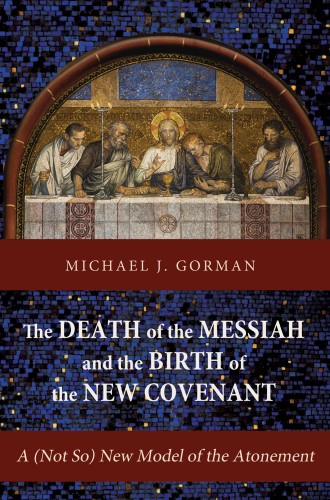The Death of the Messiah and the Birth of the New Covenant, by Michael J. Gorman
For there to be a heresy about the cross, there would have to be an orthodoxy about it. Unlike the case with Nicene specifications of christological and trinitarian doctrine, such an orthodoxy is not readily at hand in early Christian tradition or in many Christian traditions since. Early Christians pointed to Jesus, and particularly to his death and resurrection, as the hinge of history and salvation, but they did so with celebration more than with explanation. They may have agreed that Jesus was the messianic anointed One, and they saw no resulting need to edit the wide range of other roles: Teacher, Redeemer, New Adam, Healer, Liberator, Lamb.
Arguments over various atonement theories—moral influence, penal substitution, victory over the powers—are understandable, given this open space. Depending upon who’s counting, there may be three, five, eight, or ten atonement theories. But the different views are rarely strict alternatives. Jesus’ crucifixion need not be any less a moral influence for being also a victory over death. Recapitulation does not rule out reconciliation; nor does sacrifice preclude ransom. The lack of dogmatic foreclosure encourages a cumulative approach.
Read our latest issue or browse back issues.
Michael Gorman argues that contentions over a single definitive answer to how Jesus’ death saves lead to an inadequate grasp of what the passion of Christ means and does. Whichever fragment of the truth wins the argument emerges with an impoverished vision of the gospel: forgiveness but not liberation, say. As a result, the passion comes across as less momentous than it is, and the Christian life as less comprehensive than it should be.
No theory has been named for the foundations all the theories share. Gorman is in search of an encompassing model that integrates the others. As a biblical scholar, he finds the common ground for such a model in the notion that Jesus’ death is the birth of the new covenant, that multifaceted eschatological realm of shalom—community and peace. This new covenant is what the cross establishes and the church participates in. Its definition draws on the whole range of biblical tradition, and its realization in Christ is played out in various keys across the breadth of New Testament witness. This model may be the oldest and deepest, but at the same time it is the most invisible, having no name of its own.
In Mark, Matthew, and Luke, covenant is the category Jesus uses at the Last Supper to refer to his death. That emphasis is central in the tradition on the Lord’s Supper that Paul received and passed on in 1 Corinthians 11. The covenant is a reality that already has a kaleidoscopic range of features to match the church’s many images of the cross. It is a match made in heaven and reflected in scripture.
Gorman points out that each of Jesus’ three passion predictions in the synoptic Gospels has the quality of a summons. Each prefigures Jesus’ death, is met with misunderstanding or resistance by the disciples, and ends in a prescription for the life of discipleship.
In Mark 8:27–38, Peter’s confession that Jesus is the Christ is met with the teaching that Jesus will suffer and be killed, followed by an instruction to those who would follow him: that they must take up their crosses and acknowledge him and his words without shame. Gorman titles this a call to cruciform witness.
In Mark 9:30–37, a second passion prediction occasions a dispute among the disciples about who is the greatest among them. It ends with Jesus teaching that those who position themselves last shall be first. He places a child before them and says that he will welcome all those who treat such a one with the same honor as himself. Gorman names this a call to cruciform hospitality to the weak.
In Mark 10:32–45, a third prediction of the cross is followed by another dispute among the disciples about who will have power in the new realm. It ends with Jesus’ teaching that what it means to be last is to devote oneself to the service of others. He equates this directly with the Son of Man coming to give his life as a “ransom for many.” This is a call to cruciform power as loving service. The cross is the source but also the shape of salvation, the life that conforms to these calls.
Gorman’s book is a refreshing reminder not to miss the forest for the trees. His light but learned touch covers an impressive range, going far to overcome the myopia of the atonement wars. Much that is familiar and much that is not springs into focus in his treatment of covenant. He is sensitive to the supersessionist tendencies that lurk in an emphasis on the new covenant, and he draws out its continuities with Jewish sources and Jewish hope.
Gorman has no desire to supplant atonement theories but seeks only to keep them in perspective. This is well, because his book in many ways sharpens the appetite for them. He repeatedly says that Jesus’ death brought about the reality of the new covenant, and the more expansive his description of the covenant created by this single event, the more one wonders how that event works.
I appreciate what Gorman has accomplished and his gracious intent to integrate rather than displace. My hesitation is that I am not sure whether his theological umbrella is large enough. He acknowledges that early Christian theologians tended to use incarnation rather than covenant as their overarching model for understanding Jesus’ death: God became as we are in order that we might become as God is and desires us to be. That is both the what and the how of salvation. Jesus’ death stands out no less dramatically in that model—as the point where God has become most improbably and miraculously one with us—but it stands less alone alongside the entire incarnate path from Jesus’ birth, through his teaching and relationships, and on to his trial and subsequent events.
Equating salvation with the new covenant, and the new covenant’s institution with Jesus’ death, means that everything about salvation is forced into the shape of the cross: cruciform is Gorman’s adjective modifying all the nouns of salvation. It seems that because of this, each reader’s chosen atonement theory would—by defining that shape—end up ruling the day after all, which is not Gorman’s intent. Gorman has gone out of his way to show how all facets of the cross can relate to most facets of the covenant, but I would lean on the reminder that covenant and incarnation are both broader than the cross.
Particularly in our times, we need to put Jesus’ death in the frames of both the covenant, with its stress on salvation history particularity, and the incarnation, and its identification with the human condition. Jesus did say, “This is the blood of the new covenant.” Mary could have said the same thing of her own blood at his birth. Christ effectively demonstrated that his teaching, his healing, and his fellowship with the lost are likewise “acts of the new covenant” that have their part in establishing it.
The cross may be integral to salvation. But salvation does not always need to look like the cross.







